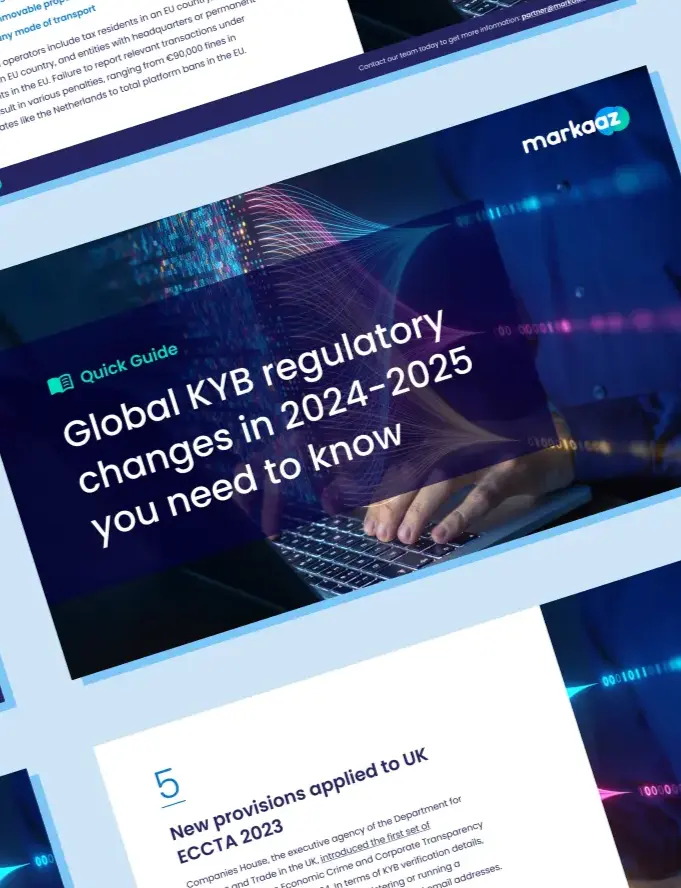The costs of onboarding fraudulent businesses are crystal clear. In 2022 alone, banks and financial institutions were fined nearly $5 billion for anti-money laundering (AML) infractions, with noncompliance fines from Know Your Business (KYB) regulations surging by 50%.
What’s less obvious, however, is the return on investment (ROI) of business verification solutions. Beyond circumventing noncompliance fines, business verification services simplify AML and KYB processes, reduce the human capital necessary for manual application review, and even enhance new customer acquisition to drive more estimated lifetime revenue per approval.
Yet this still begs the question: How do you assign a dollar value to business verification ROI? In this guide to calculating the ROI of business verification, we’ll explore the key metrics and formulas necessary to quantify the financial impacts of business verification services.
What is the ROI of business verification?
Organizations can incur millions in fraud loss and AML compliance fines for onboarding fraudulent businesses and criminal enterprises. So it comes as no surprise that business verification solutions have become integral components of AML compliance processes, working to enhance KYB fraud detection and sanction screenings and validate B2B data for more confident approvals.
AML compliance standards have become more stringent in recent years, and business verification services have enabled organizations to generate additional lifetime value by safely verifying more businesses. The ROI of business verification illustrates the estimated revenue lift achieved by these legitimate businesses, as well as the reduction in costs dedicated to manual reviews.
Without reliable business verification tools, validating the legitimacy of applications requires human analysts to evaluate businesses on a per-application basis. As a people-driven operation that can require anywhere from 1,000 to 3,000 full-time analysts just to manage KYB screenings, the majority of financial institutions spend approximately 1-2 months to review a single corporate client.
When you consider the human capital and overhead costs, which can reach upwards of $3,500 per application review, manual verification expenses can become crippling. For that reason, the ROI of business verification tools is measured by two elements: the additional lifetime value generated by verifying more legitimate businesses and the reduction in manual verification costs.
By factoring in both elements, you can calculate a tangible dollar value for business verification ROI.
How to calculate business verification ROI
Whether you’re weighing the cost benefits of a data verification company or wanting to quantify the efficacy of a newly implemented solution, the best place to start is by calculating the potential ROI. Here’s a step-by-step guide to calculate business verification ROI, with tips for helpful tools.
1. Gather key data and metrics
The first step for calculating the ROI of business verification is collecting relevant data. Business verification ROI is determined on an annual basis, so it’s wise to gather metrics from the previous year for the most holistic look at your organization’s data.
Look through your internal database to locate the following:
- Number of applications you must verify per year
- Number of applications you can’t verify per year
- Number of additional verifications gained through verification services per year
- Amount of lifetime revenue per verified business customer
- Number of business records requiring manual review per year
- Average manual verification cost per application
When determining the average manual verification cost per application, bear in mind the total labor costs for the employees spearheading KYB screenings, including annual salaries, payroll taxes, and benefits packages. Also, factor in total overhead expenses, including the costs of office rent, utilities, and required software for the duration of a single application review.
2. Apply the business verification ROI formulas
Once you’ve identified the relevant figures, you can begin to calculate business verification ROI. Remember, you’re calculating two ROI amounts here: the estimated revenue gain from additional verifications and the cost savings from a reduction in manual escalations.
Estimated revenue gain = additional verifications x customer lifetime revenue
Imagine your organization needs to verify 20,000 applications per year. You previously could not verify 10,000 applications and manually reviewed 5,000. Business verification services allowed you to verify an additional 30% of those 10,000 applications, which enabled an increase of 3,000 customers per year. If the lifetime revenue for business customers is $10,000, the formula for business verification ROI would look like this:
Estimated revenue gain = 3,000 x $10,000
Estimated revenue gain = $30,000,000
Next, you’ll need to quantify the time saved leveraging business verification services in lieu of manual escalations. To do so, you’ll need to determine the average manual verification cost per application (described above), then multiply that amount by the number of manual reviews per year to find the total annual cost.
Total cost of manual reviews = cost per application x number of applications requiring review
For example, if you calculated your average manual verification cost per application to be $2,000 and you previously manually reviewed 5,000 applications, the formula would look like this:
Total cost of manual reviews = $2,000 x 5,000
Total cost of manual reviews = $10,000,000
Now, to determine the cost savings of verification, compare the previous cost of manual reviews to the current cost with business verification services. If business verification services automated another 3,000 verifications per year, it could bring the number of manual reviews down to 2,000.
So the new cost of manual review would be as follows:
Total cost of manual reviews = $2,000 x 2,000
Total cost of manual reviews = $4,000,000
Compared to the previous $10,000,000 in manual verification costs, the implementation of business verification services saved $6,000,000 annually. These savings are in addition to the $30,000,000 estimated revenue gain, bringing the total business verification ROI to $36,000,000.
3. Simplify with a verification ROI calculator
Due to the numerous impacts of verification (and the multiple formulas), manually calculating business verification ROI is not as straightforward as multiplying a few numbers. You can streamline this process by using a reputable business verification ROI calculator.
The business verification ROI calculator by Markaaz uses a fraction of the insights you would have needed to gather for manual calculations, making the process far easier. All you need to do is plug in the number of applications you need to verify, the number you cannot verify, the lifetime revenue from your business customers, and the number of records requiring manual review.
The calculator will assume a $2,000 standard manual verification cost per application, the industry average to review a single corporate client, so you don’t have to gather various labor and overhead costs related to application review.
From here, it will determine the business verification ROI on a 30% increase for the revenue increase estimate, making it dramatically simpler to conceptualize the boost in estimated customers and additional lifetime revenue. Rather than spend hours gathering figures and applying various formulas, the business verification ROI calculator makes understanding ROI as simple as 1, 2, 3.
Enhance verification rates, drive additional revenue
The ROI of business verification extends far beyond AML compliance and KYB regulations. With reliable business verification services, organizations can safely approve thousands more businesses per year, driving additional revenue streams and decreasing manual escalations.
Markaaz is a leading KYB data provider and business verification solution designed to simplify how organizations confirm the authenticity and lawfulness of business partners and clients. Connect with our team today to learn how your organization can capitalize on business verification.




